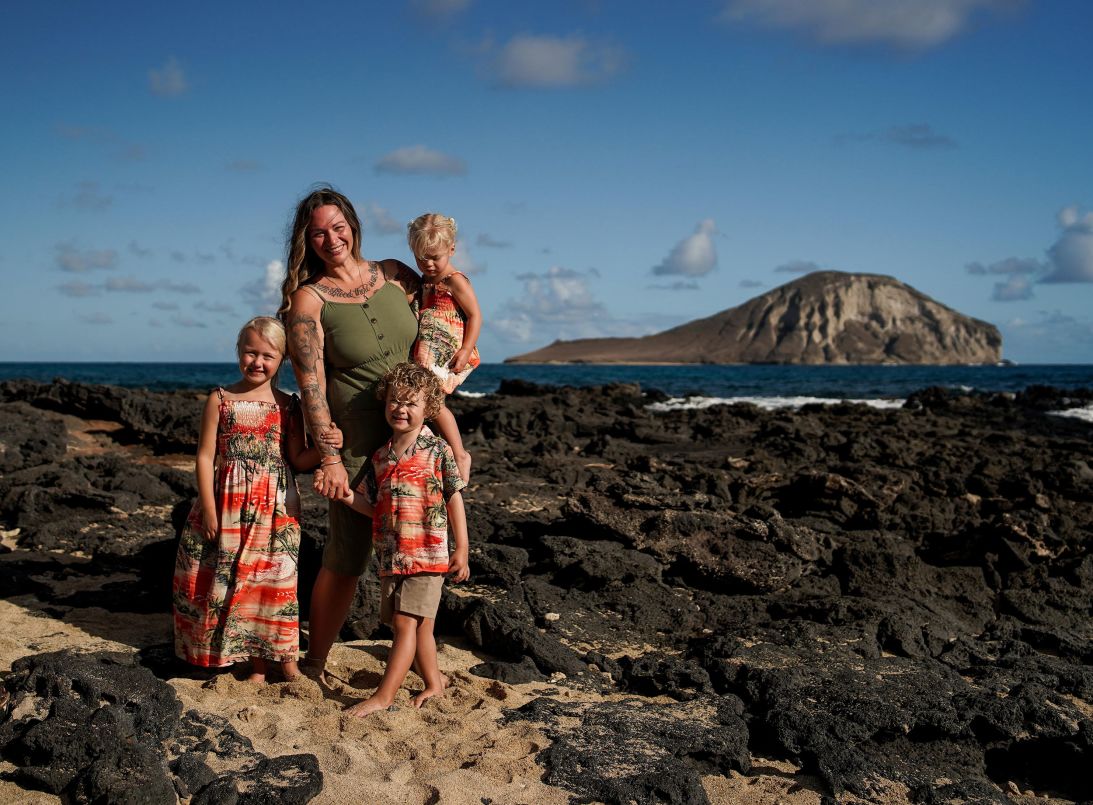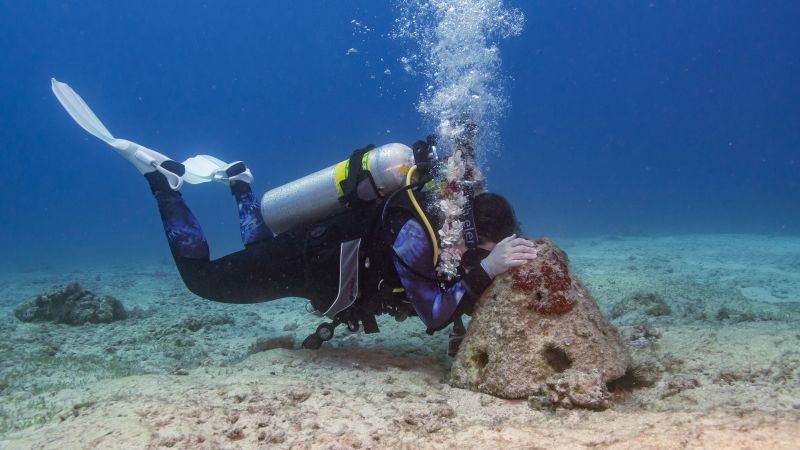Tea-tree-scented steam from her husband’s morning shower still lingered in the air when Ashley Bugge’s phone rang.
Bugge was getting her two toddlers ready for a grocery store run. Six months pregnant, she moved slowly as she sifted through the jumble of keys, snacks and plastic toys in her bag to find her phone.
It was an unknown number. She answered it, and everything changed.
“Is this Brian’s wife?” a panicked voice asked. “There’s been an accident on the dive boat.”
Her husband, Brian Bugge, was finishing a specialized scuba diving course that day near their home in Honolulu, Hawaii. He’d left that morning for a dive to the Sea Tiger, a sunken ship 90 feet beneath the ocean’s surface. She expected his call later that afternoon saying he was done.

But something had gone horribly wrong.
Minutes later Ashley Bugge found herself at an ER reception desk, pleading for information on her husband. A doctor approached her with another person who appeared to be a security guard. She knew then that Brian hadn’t made it.
She collapsed on the floor, her piercing screams unfamiliar to her own ears. “No, no, no,” she sobbed.
Soon after that call on May 20, 2018, Bugge learned that her husband had mistakenly left his his oxygen supply off, leaving him suddenly without air underwater.
Her world shattered. But in the months that followed, she found a unique way to memorialize her husband through the ocean he loved so much.
Their biggest moments unfolded in and around the sea
The couple met in Oregon in their late teens.
At the time they both lived in the Portland area, where Brian played in a punk band with a friend of Ashley’s brother. She often attended their shows, and she and Brian started going out not long after.
They spent most of their dates exploring spots along the Pacific coastline. At age 20, Brian Bugge had his life mapped out – he was going to join the Navy or Coast Guard, then marry Ashley, she said.
She felt they were too young to settle down, so they went their separate ways. But they remained in the same circles, and in early 2013 — nearly a decade later – they reconnected after he left a flirty message on her Instagram.
“It was something stupid … some sort of comment about the weather or something,” she said. “But I knew like, oh, if he’s reaching out, something’s going on.”
Their phone calls after that lasted hours as if no time had passed, she said. Later that summer, after he returned from a Navy deployment, they met to exchange belated birthday gifts — his was in June, hers in August. Both had unknowingly chosen the same thing: scuba diving lessons. It was the moment everything changed.
They realized they never wanted to be away from each other, and made a promise to do whatever it took to make it work.
“This second time around, both of us knew, this is it. You’re my person. Let’s figure this out,” she said. “And then we were like, ‘we need to get married and live happily ever after.’ And so we did.”
They were married in Manzanita, a scenic stretch of Oregon coastline known for its rugged cliffs and fiery sunsets – and the same spot where they had exchanged their first “I love yous” nine months earlier.
The ocean was always a backdrop for their love story.
As Brian Bugge’s Navy career took him across the world, they seized opportunities to dive together in Japan, Australia and Fiji.
And in the summer of 2017, he was assigned to the naval base at Pearl Harbor in Hawaii.

The specialized scuba course that day was a rebreather dive class.
It had been postponed several times, and Brian Bugge was looking forward to finally being done with it.
Certification on the rebreather system, which recycles the diver’s air, would have marked another ocean milestone for him. It’s such an elite skill that Navy SEALs sometimes use it for stealth operations because it produces no bubbles underwater.
His wife recounted the events of that fateful dive: Brian prepared in the boat to make sure the machine was working, then turned it off to conserve oxygen. But he forgot to turn it back on before he got in the water, leaving him without air after he descended, she said. He drowned within six minutes of entering the water.
“He became hypoxic, fell asleep, the loop came out of his mouth and then he just inhaled salt water … his instructor wasn’t even in the water yet,” Ashley Bugge said. “At first, his instructor thought it was a prank, so he briefly watched him go down and hit the ocean floor. And then he realized there was a bigger issue and went down after him.”
Brian Bugge was 35. Ashley was six months pregnant with her youngest child, Addy, when the call came. Their two oldest children, Hudson and Izzy, were 1 and 3, respectively.
One moment, she was a happy wife dreaming of baby names. The next, she was a young widow with two toddlers, a third baby on the way and bouts of crushing grief.
And she wondered: How could she honor the love of her life in a way that captured his maritime spirit?
Six months after his death, she got a call from Living Reef Memorial, a California company that helped families place cremated remains in eco-friendly structures designed for the ocean floor.
Ashley Bugge had never heard of such a thing. But to her a memorial reef sounded ideal for a man who craved ocean adventures.
“As soon as I knew that was a thing, I said, ‘yes, we need to do this,’” she said.
She sent them some of her husband’s ashes, and a few weeks later, a man delivered the memorial reef – covered in an American flag – to Honolulu.
Memorial reefs blend a loved one’s ashes with concrete to create structures that rest on the ocean floor, said Matthew Bracken, a professor of ecology and evolutionary biology at the University of California, Irvine.
They are a unique variation on the artificial reefs that scientists build to support marine life and replace natural reef systems, which have been harmed by warming oceans.

Artificial reef habitats aren’t as effective as natural ones, but when placed with care and scientific guidance, they can be beneficial to marine ecosystems, Bracken said.
Ben Ruttenberg, an associate professor at Cal Poly and director of its Center for Coastal Marine Sciences, said he did a fish-counting dive at Neptune Memorial Reef, an underwater cemetery near Key Biscayne, Florida.
“If you have a big patch of sand and structure, fish love that stuff and they’re going to come hang out … you’re going to attract a whole community,” he said.
Artificial reefs are part of a broader strategy to address the challenges of climate change. “If we don’t start to aggressively reduce our carbon emissions and tackle climate change as the global threat that it is, coral reefs as we know them may cease to exist,” Ruttenberg said.
Memorial reefs are so rare that scientific data on their effect on local ecosystems is essentially nonexistent, he said.
“But if every single person on the planet suddenly decided that they wanted to be cremated and placed on these things, that would be a different story,” he said.
She’s carrying on her husband’s passion for the ocean
Brian Bugge’s love of the ocean ran deep.
In July 2017, he set sail from Gig Harbor, Washington, to Honolulu with three friends aboard his sailboat, Stay Gold. He was relocating to Hawaii to begin his service at Pearl Harbor. Ashley flew with the children and met them in Honolulu.
Toward the end of the three-week trip, Brian wrote an entry in his journal:
“I don’t have a bucket list. I don’t have a trip of a lifetime. Every trip is the trip of a lifetime because that could be the last trip I go on. A bucket list insinuates that we have time to do things before we die. We don’t. … Today is your life. Tomorrow may never come.”
For Ashley Bugge, those words took on new resonance after she lost her husband. In carrying on his love of the sea, she said she found a deeper connection to him — and has rediscovered herself.
She has since moved to Vancouver, Washington, with her three children and recently earned a doctorate in education leadership with a specialty in ocean science. She’s co-founded The Seabirds, a nonprofit that educates young people about ocean science.
She’s also written a memoir, “Always Coming Back Home” about her love, loss and journey to find herself in the aftermath of tragedy.

“There’s no separation of me and the ocean. It’s a part of my identity now. Every big thing in my life is tied to the ocean,” said Bugge, now 42.
She hopes her story will help people — especially young military spouses — have open-hearted conversations around grief.
“I want people to feel empowered that if this crazy widowed mom of three has been through all this and done all this … other women can, too. It’s hard … but you have to try and find your passion.”
Diving is one of the ways she keeps her husband’s story alive for their children.
On May 20, 2019, the first anniversary of Brian’s death, she and his Navy friends dove to the Sea Tiger wreck where he died. Later that day they placed his memorial – a cone-shaped structure about 3 feet tall – on the ocean bottom at the spot near where the couple shared their first dive.
It’s become an annual tradition to honor Brian’s memory.
Next year, when her son Hudson turns 10, he will dive to his father’s memorial for the first time, stepping into the world of a man he never got a chance to truly know.
Today Brian Bugge is part of the ocean and part of the land.
Some of his ashes are interred at the National Memorial Cemetery of the Pacific in Honolulu, a military cemetery often referred to as the “Arlington of the Pacific.” Etched on his gravestone are words he lived by: “Live a life you will remember” — taken from lyrics to a favorite song.
Ashley donated his organs and tissue, but she couldn’t bring herself to give away his eyes.
“He had these beautiful blue eyes … and I just couldn’t picture him without them,” she said.
And in a final act of love, she said, she gave him back to the sea.
The ocean was his refuge, his playground, his calling. It may have taken him, but it also gave him purpose and clarity when he was alive, she said.
“It’s always been our thing together. And that hasn’t shifted now that he died in the ocean – it’s an even a bigger part of our story now.”

At her most recent memorial visit in May, Ashley Bugge slipped beneath the surface of the Pacific in full scuba gear, following the ocean coordinates she now knows by heart.
Above the waves, friends and her three children gathered in a boat – like they do every anniversary since the memorial reef was placed on the ocean floor.
They played her husband’s favorite song, “The Nights” by Avicii, in the boat.
“He said, one day, you’ll leave this world behind
So live a life you will remember …. “
Forty feet below, Ashley Bugge gently wrapped her arms around her husband’s memorial and rested her head on it. She draped a purple lei around it as a sea turtle floated nearby in the turquoise waters, a silent witness to her love and grief.

